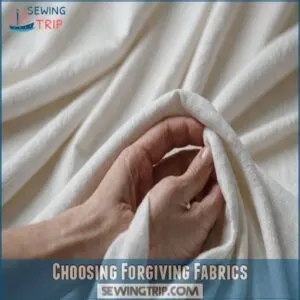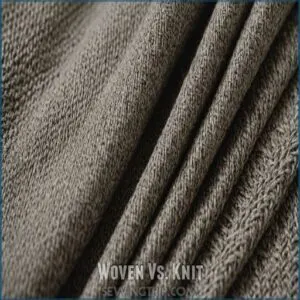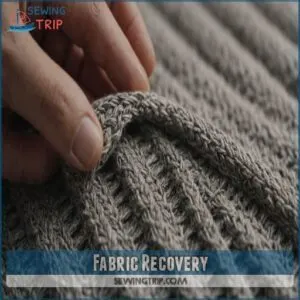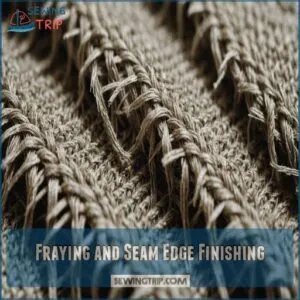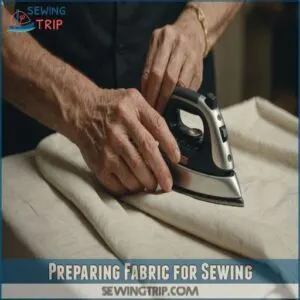This site is supported by our readers. We may earn a commission, at no cost to you, if you purchase through links.
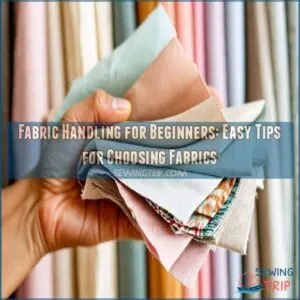
Imagine them as the bread and butter of sewing, giving you a smooth ride without too many hiccups.
Don’t ignore knits with a bit of stretch; they’re like old friends—flexible and dependable.
Remember, storing fabrics in breathable bags is key to avoid any musty surprises!
A mix of gentle folding and thoughtful pressing keeps things in shape.
Ready to learn more sewing secrets? There’s a lot more on understanding fabric properties just around the corner.
Table Of Contents
Key Takeaways
- Start with forgiving fabrics like cotton and linen to avoid frustration and make learning easier.
- Pre-treat fabrics by washing them to prevent shrinkage and surprise issues after sewing.
- Use proper tools like sewing machines, sharp scissors, and straight pins for smooth sewing and fabric handling.
- To ensure even seams and a perfect garment fit, knowing the grainline of your fabric is essential, as it refers to the direction in which threads intersect in woven fabric, as explained in sewing terms guide. Understand fabric grain direction to ensure even seams and a perfect garment fit.
Choosing Forgiving Fabrics
When you’re starting out with sewing, choosing forgiving fabrics like cotton and linen can save you a lot of headaches and frustration.
These fabrics are easy to handle and fix, making them perfect for those moments when your first stitch doesn’t quite hit the mark.
Stable Fabrics for Beginners
Think of stable fabrics like the training wheels of your sewing journey—they keep things steady.
Start with options that are easy to handle, minimizing common mistakes.
Fabrics with good stability, such as medium-weight denim (8-12 oz) suitable for everyday projects, provide better results when sewing denim at home. Fabrics with good stability won’t stretch or slip, helping you master sewing techniques without the drama.
Perfect for beginners, these forgiving materials turn pattern selection and project ideas into a breeze.
Cotton for Easy Handling
When you’re diving into sewing, cotton’s a superstar.
It’s sturdy yet soft, making it forgiving for beginners’ slips.
Different cotton types let you explore everything from featherweight voiles to chunky quilting cotton.
Don’t fret if you wrinkle it—just give it a quick iron.
With easy handling and care, cotton’s like that reliable friend always ready to help you out.
Knits With Stretch Properties
Knits, the fabric world’s yoga pants, offer comforting flexibility.
Get into their forgiving nature with these tips:
- Use stretch knit needles to glide through fabric without snags.
- Explore knit fabric stores like those found at Knit Fabric Projects for a wide range of knit fabric types.
- Embrace knit fabric
Linens Beginner-Friendly Texture
So, you’ve tackled knits; now let’s explore linen!
It’s surprisingly beginner-friendly.
Linen’s natural drape is gorgeous, but those wrinkles? Don’t sweat it!
Proper linen care is key.
Practice linen sewing on smaller linen projects first.
Mastering linen handling will boost your fabric skills.
Plus, linen projects look amazing!
What’re your favorite linen sewing tips?
Let’s chat!
Understanding Fabric Properties
When choosing fabric, consider factors like fabric type and texture, When you understand the basic properties like whether it’s woven or knit, or how well it bounces back (recovery), can save you a lot of headaches.
It’s a bit like knowing how your favorite pair of jeans will handle a pizza stain; the more you know, the better your final creation will turn out!
Woven Vs. Knit
You’ve picked out your fabric, but now you’re wondering about woven versus knit.
If you’re looking for more information on the differences between these two, check out some products related to woven vs knit comparisons.
Woven fabrics are all about stability, making them a breeze for stitch lovers who value precision in grain direction.
When working with stretchy materials, it’s crucial to learn how to sew stretchy fabric without puckering. Meanwhile, knit fabrics bring stretchiness to
Fabric Recovery
Switching gears a bit, ever wondered why some fabrics bounce back after stretching?
That’s fabric recovery for you.
Knits are champs at this due to their inherent stretch and bounce properties, making them ideal for comfy wear.
Woven fabrics, on the flip side, have little recovery, needing extra care to avoid wrinkles and creases.
Ironing and steaming can help maintain their shape.
Fraying and Seam Edge Finishing
Once you understand fabric recovery, fraying and seam edge finishing become the next challenge.
Woven fabrics fray easily, requiring neat finishes.
Try using pinking shears or a zigzag stitch to keep edges tidy.
Serging techniques or an overcasting stitch can also do wonders.
Remember to keep seam allowances in mind to avoid cutting corners, both literally and figuratively!
Preparing Fabric for Sewing
Before you start sewing, it’s essential to prepare your fabric by pre-treating it to prevent any surprises during your project, and trust me, no one likes shrinkage at the worst possible moment.
You’ll also want to give your fabric a good press; it’s like ironing out life’s little wrinkles, making sure everything lays smooth and ready for the needle.
Pre-Treating Fabrics
Think of pre-treating fabrics like giving them a spa day before sewing.
It’s essential to avoid surprises such as shrinkage later on, especially when working with natural fibers like cotton, linen, or silk that require a gentle pre-washing process to prevent shrinkage and color bleeding as explained in pre-washing different fabric types.
Here’s what you do:
- Pre-wash fabrics to check for
Pressing
Now that your fabric’s prepped, let’s talk pressing.
Proper pressing is key, you know.
Use a hot iron and a pressing cloth online to avoid scorching delicate fabrics.
Press seams open for a professional look; it’s a game-changer.
Different fabrics need different techniques, so experiment to find what works best for you.
Avoid those pesky wrinkles.
Frequently Asked Questions (FAQs)
What Are Some Common Beginner Sewing Mistakes and How Can I Avoid Them?
Don’t worry, mistakes happen even to seasoned pros!
Forgetting seam allowances or choosing tricky fabrics?
Don’t sweat it.
Stick to forgiving materials like cotton, always double-check measurements, and practice on scraps to refine your skills.
My Sewing Machine is Jamming, What Should I Check or Adjust to Fix This?
Your sewing machine jamming? Frustrating, right?
Check for tangled threads, rethread both spool and bobbin, and clean dust from the feed dogs.
Make sure the needle isn’t bent or dull.
These simple tweaks often solve the issue!
How Do I Make Adjustments if the Finished Garment Doesn’t Fit Properly?
First, breathe!
Let out those side seams if it’s tight or add darts if it’s baggy.
Pinch, pin, and stitch with patience.
Remember, even pros tweak their garments.
Fitting’s where true sewing mastery shines!
Are There Any Good Beginner Sewing Projects for Learning to Sew Knit Fabrics?
Think tackling knit fabrics is intimidating?
Try starting with simple projects like a cozy infinity scarf or a basic knit beanie.
They’re perfect for honing skills like stretch stitching, and you’ll wear them proudly!
What is the easiest fabric to work with for beginners?
Cotton’s your best bet!
It’s forgiving, easy to sew, and comes in tons of colors.
Plus, it’s readily available, making it perfect for your first projects.
You’ll master the basics in no time!
How do you gather fabric for beginners?
Gather fabric by sewing two lines of long stitches, like you’re drawing parallel tracks.
Tug on the threads to bunch the fabric gently.
It’s like creating ripples, making sure threads don’t break with a gentle touch.
What fabrics are hard to handle?
To master the art of working with slippery fabrics, it’s essential to understand the importance of pre-washing and using the right needles, as discussed in Cutting Slippery Fabrics Accurately. Sewing slippery fabrics like silk is a juggling act, requiring practice to tame its wild ways.
Knits, although cozy, stretch unpredictably.
Satin, velvet, and chiffon love to fray, needing careful handling.
They’re tricky, yet rewarding with skill!
What is the best way to hold fabric together?
Straight pins are your best buddies for holding fabric together.
They’re great for temporarily bonding pieces during sewing, making adjustments a breeze.
For thicker fabrics, consider clips—they’re like tiny clamps holding everything snugly.
How to cut fabric without fraying?
Worried about your fabric fraying?
Use pinking shears or a rotary cutter with a zigzag blade to cut fabric.
These tools create zigzag edges, preventing the threads from unraveling and keeping your project neat and tidy.
What tools are essential for fabric handling?
You can’t go wrong with these tools: a quality sewing machine, sharp dressmaking scissors, a seam ripper for those "oops" moments, straight pins, a trusty iron, a measuring tape, extra bobbins, and fabric markers. To get started, it’s essential to invest in a quality secondhand sewing machine for smooth operation with each project.
How to store fabric to prevent wrinkles?
Did you know 60% of fabric wrinkles occur from poor storage?
Roll your fabrics to keep them smooth and use breathable bags to prevent moisture buildup.
Store fabrics in a cool, dry place, and check humidity regularly.
How is fabric grain important in sewing?
Understanding fabric grain is really important!
It dictates how your fabric stretches and hangs.
Cutting with the grain guarantees even seams and prevents wonky garments.
Ignoring it? Prepare for frustrating fitting issues!
How do you set the correct stitch length?
Setting stitch length is like adjusting music volume; too short and it’s chaos, too long and it’s loose.
Start at 5mm for standard fabrics,
tweak for thinner or thicker materials,
and enjoy sewing harmony!
Conclusion
Imagine this: a friend handles delicate fabric with ease, and you want that same confidence.
Delving into fabric handling for beginners, you now have the basics down.
Opt for forgiving fabrics like cotton and linen, understand fabric types, and master preparation techniques.
These tips transform mishaps into masterpieces.
Don’t hesitate to experiment and share your own sewing stories. Every project boosts your skills, making you more adept at choosing and handling fabrics effortlessly.

